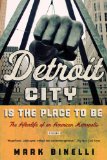Summary | Excerpt | Reviews | Beyond the Book | Readalikes | Genres & Themes | Author Bio

Critics' Opinion:
Readers' Opinion:
First Published:
Nov 2012, 336 pages
Paperback:
Nov 2013, 336 pages
 Book Reviewed by:
Book Reviewed by:
Poornima Apte
Buy This Book
Introduction
Back when I was a boy, growing up just outside of Detroit, my friends and I beheld any mention of the city in popular culture with a special thrill. We loved how Detroit was deemed terrifying enough to be chosen as the dystopian locale of RoboCop, the science fiction film set in a coyly undated "near future," when Detroit had become so dangerous that the outsourcing of law enforcement to an armored, heavily weaponized cyborg would seem a prudent and necessary move. And when the producers of Beverly Hills Cop decided to make the hometown of Eddie Murphy's fish-out-of-water detective our own—because, after all, what could be more antipodal to Rodeo Drive than Woodward Avenue, what more alien presence to the Beverly Palms Hotel than a black dude from Detroit in a Mumford High T-shirt?—we delighted in that, too. We certainly tested the speakers of our American-made Dodge hatchbacks whenever a Detroit song found itself played on one of the competing local rock stations. Who would be churlish enough to flag these songs as relics of an earlier era or point out how the lyrics pivoted off the city's reputation for chaos, riotousness, destruction to such a degree the very titles—"Panic in Detroit" (Bowie, 1973), "Detroit Breakdown" (J. Geils Band, 1974), "Motor City Madhouse" (Nugent, 1975)—could be mistaken for headlines from July 1967? To this day, when the plangent opening piano chords of Journey's "Don't Stop Believin' " blare from a dive bar jukebox, who among us begrudges even this most overplayed of power ballads a respectful split-second cock of the head and perhaps a secret inner smile as well, all because the protagonist of the song was "born and raised in South Detroit"—no matter that there wasn't really a neighborhood called South Detroit or that the person living there wanted so badly to get the hell out he took a midnight train goin' anywhere.
My parents subscribed to Time, and I can remember excitedly reading a story, at the height of the tension between Ronald Reagan and the Soviet Union, detailing the effects of a single nuclear bomb dropped on a major American city. This city, the editors explained, had been chosen entirely at random—but of course it was Detroit, a choice that by 1982 probably came across to most locals as an ungallant case of piling on. Still, at twelve years old, I devoured the shout-out as if the city had won some national lottery.
The article began, "Say it is late April, a cloudless Thursday evening in Detroit. Assume further that there is no advance warning."
Beginning at ground zero of the blast and expanding concentrically, the story proceeded to describe, in gruesome detail, the fate of Detroit and its residents. If you happened to be watching a baseball game at the old Tiger Stadium, for example, you would immediately go blind. Then you would burst into flame. "But," the writer continued, unhelpfully, "the pain ends quickly: the explosion's blast wave, like a super-hardened wall of air moving faster than sound, crushes the stands and the spectators into a heap of rubble."
Skyscrapers topple. Commuters melt inside their cars. Even Canadians in neighboring Windsor—this I found particularly satisfying—would be fatally pelted with fragments of the Renaissance Center, "hurled across the river by 160-m.p.h. winds." Following the geography of the article to my family's own suburb, I learned that, only a minute after the blast, fires would be already raging and "tens of thousands" of people dying, survivors "crawl[ing] from wrecked homes" to see an eight-mile-high mushroom cloud in the distance.
But—survivors! See, I pointed out to my little brother, even at that early age displaying the hopeful spirit that all Detroit-area natives learn by necessity to cultivate like a rare breed of flower. One of us might live!
Detroit used to be the greatest working-class city in the most prosperous country in the world. With the explosion of the auto industry, it had become the Silicon Valley of the Jazz Age, a capitalist dream town of unrivaled innovation and bountiful reward. My family came from Italy, our neighbor from Tennessee, my dad's friends were from Poland, Lebanon, Mexico. All had been drawn to Detroit, if not explicitly for the auto industry—my father sharpened knives and sold restaurant equipment—then because of what the auto industry had come to represent. The cars rolling off the assembly lines existed as tangible manifestations of the American Dream, the factories themselves a glimpse of the birth of modernity, in which mass production would beget mass employment and, in turn, mass consumption. Workers, eager to claim their share of the unprecedentedly high wages on offer, migrated to the city in droves, doubling Detroit's population in a single decade, from 465,000 to nearly a million, making the city, by 1920, the fourth largest in the nation. The art deco skyscrapers bursting from the downtown streets like rockets must have seemed like monuments to Fordism's manifest destiny. Everything pointed up.
Excerpted from Detroit City Is the Place to Be by Mark Binelli. Copyright © 2012 by Mark Binelli. Excerpted by permission of Metropolitan Books. All rights reserved. No part of this excerpt may be reproduced or reprinted without permission in writing from the publisher.




A classic is a book that has never finished saying what it has to say
Click Here to find out who said this, as well as discovering other famous literary quotes!
Your guide toexceptional books
BookBrowse seeks out and recommends the best in contemporary fiction and nonfiction—books that not only engage and entertain but also deepen our understanding of ourselves and the world around us.